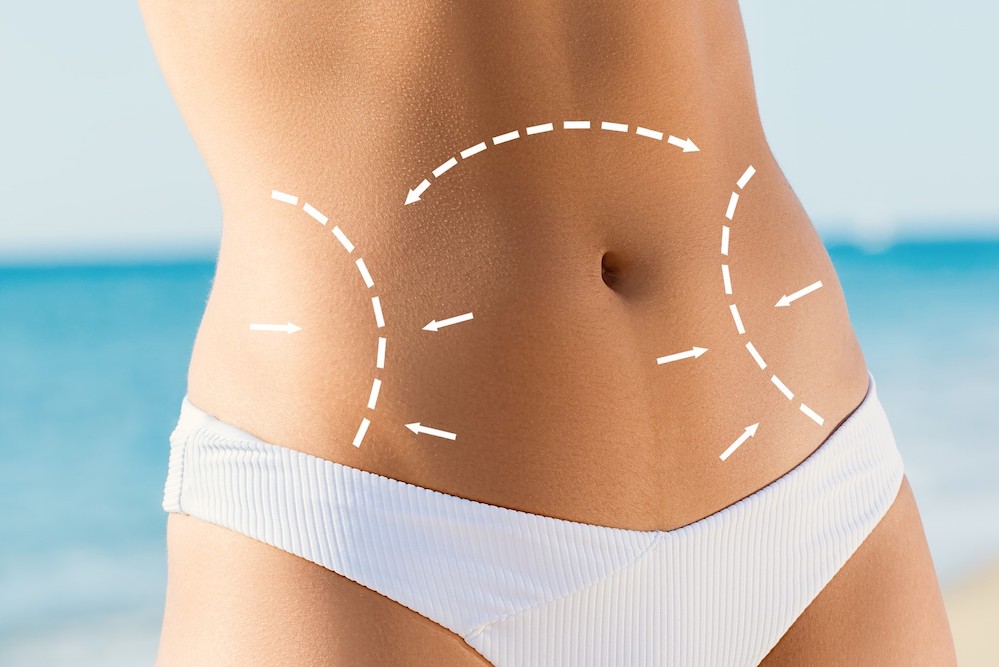Abdominoplasty

Our board-certified plastic surgeons can help shape your midsection with a tummy tuck, otherwise known as an abdominoplasty
Tummy tuck, also called abdominoplasty, is a procedure that removes the excess loose skin and fat from the lower abdomen while also tightening the muscles of the abdominal wall. Tummy tucks are common following pregnancies and significant weight loss but may be desired by anybody who has excess skin and fat, or muscle laxity that impairs abdominal contour. When there is significant stretching of the abdominal skin and musculature following weight gain or pregnancy, there are frequently changes that occur to the lower abdomen that do not improve, even with aggressive diet and exercise. Improving contour and reducing stretch marks and excess skin from the lower abdomen can significantly improve self-image and self-confidence both in and out of clothing.

There are several varieties of abdominoplasty, including full abdominoplasty, high lateral tension abdominoplasty, lipo-abdominoplasty (tummy tuck combined with liposuction), mini-abdominoplasty, circumferential abdominoplasty (lower body lift), and fleur de lis abdominoplasty. Our surgeons will discuss each of these procedures, the advantages and disadvantages of each, and which you may be a good candidate for during your consultation.
Looking for a Plastic Surgery Consultation?

Abdominoplasty FAQs
How is an abdominoplasty done and what scars can I expect after surgery?
The most common procedure performed by our surgeons is a full abdominoplasty combined with liposuction. In this procedure, all of the skin, stretch marks, and excess fat in the lower abdomen, between the pubis and belly button are removed. The belly button is cut out and left behind in its original location. Sutures are then placed in the abdominal muscles to tighten them, reduce bulging, particularly in the lower abdomen, and improve abdominal contour – essentially acting as an internal corset to reconstruct the hourglass figure. The skin from the upper abdomen is loosened and stretched down so that it can be approximated to the lower abdominal incision. Finally, an opening is made in the upper abdominal skin that has been redraped to bring the belly button out and suture it in place. Liposuction can be performed in the areas desired to improve contour.
The typical abdominoplasty scar is located usually across the lower abdomen and well hidden by a bikini or undergarments. In a full abdominoplasty there is also an incision placed on the inner border of the belly button that usually heals inconspicuously. In some procedures, such as the mini-abdominoplasty, the lower abdominal incision may be shorter and the incision around the navel can be avoided. In other cases, longer or additional incisions may be necessary, including a vertical incision if there is not enough skin excess to remove all of the skin up to the umbilicus or if there is so much skin excess that additional vertical skin resection would be beneficial (fleur de lis abdominoplasty). In patients where laxity extends around the flanks and into the back, a circumferential abdominoplasty may be performed, leaving a scar all the way around the waistline.
How do I know if I need a liposuction or tummy tuck?
In multiple areas of the body, including the abdomen, arms, and thighs, people debate between liposuction and procedures where skin is excised, such as a tummy tuck, thigh lift, or arm lift (brachioplasty). The obvious advantage of liposuction alone is that there is minimal scarring from the procedure, and the recovery tends to be much quicker. Liposuction is great for reducing the bulge in localized areas of excess fatty tissue. However, it does very little at improving issues related to the excess skin. In most cases, the skin will shrink and contract some following liposuction but as people age or in people with poor skin elasticity this may be seen less. Skin excisional procedures leave a more significant scar and take longer to recover from, but they directly deal with the issue of skin excess. After a thorough discussion and examination during your consultation, our surgeons will give you their recommendations. The good news is that if you are on the fence, and decide to go with liposuction instead of a more involved procedure, you can always come back and excise the skin later if you are concerned about the appearance of loose skin.
Should I lose weight before undergoing a tummy tuck?
In general, it is best to achieve your lowest stable weight prior to undergoing abdominoplasty in order to obtain the optimal result. Losing weight will decrease the thickness of the abdominal wall. Reduction of intra-abdominal fat, which is the fat around the abdominal organs within the abdominal wall, can only be achieved with diet and exercise. Decreasing the amount of fatty tissue present prior to surgery will allow your surgeon to remove the maximum amount of excess skin and give you the most desirable result.
It is not uncommon; however, for patients to plateau at a weight above their goal with diet, exercise, and even weight loss surgery. In many cases, a safe and dramatic improvement can still be obtained with abdominoplasty under these circumstances.
What should I expect during recovery from a tummy tuck?
Following a tummy tuck, patients may be discharged home with a responsible adult to help care for them, or admitted to the hospital or nursing facility initially for observation the first night or two after surgery. Depending on the extent of dissection and skin excision, drainage tubes may be used. The abdomen can be quite sore following this procedure but various pain medications and internal numbing medications will be given to control the pain. Even though you will be sore, it is important to be going for short walks around the house immediately after surgery. You will need assistance when doing this for the first few days during the greatest period of discomfort. Patients should know that it can take several weeks before you are feeling back to yourself. Most patients take about 2 weeks off from work depending on the nature of their job and how quickly they heal. There should be no heavy lifting or strenuous exercise for 4-6 weeks. It will be several months before the aesthetic outcome of the procedure can be judged. It takes time for the swelling to go down and the scars to soften and mature.
“Any procedures that I’ve had there have been done with the utmost care and concern for my health and comfort. They’ve always been able to check over things with my insurance to make sure there won’t be any billing hiccups down the road.”
Caletta G
Schedule an appointment today
Locations in Paradise Valley and the greater Phoenix area


